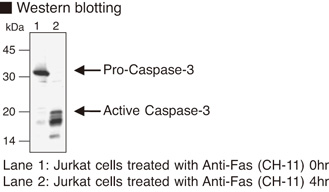Anti-Caspase-3 (Human) mAb
| Code | Size | Price |
|---|
| MBL-M097-3 | 100 ug | £301.00 |
Quantity:
Prices exclude any Taxes / VAT
Overview
Host Type: Rat
Antibody Isotype: IgG2a
Antibody Clonality: Monoclonal
Antibody Clone: 1F3
Regulatory Status: RUO
Target Species: Human
Application: Western Blot (WB)
Shipping:
4°C
Storage:
-20°C
Images
Documents
Further Information
Applications:
WB - 1 ug/mL (chemiluminescence detection system)
Background:
Caspase-3 (also known as CPP32, Yama, apopain) is a key member of the caspase family of cysteine proteases. Caspase-3 exists in cells as an inactive 32 kDa proenzyme. During apoptosis procaspase-3 is processed at aspartate residues by self-proteolysis and/or cleavage by upstream caspases, such as caspase-6, -8, or -9. The processed form of caspase-3 consists of large (17 kDa) and small (12 kDa) subunits which associate to form the active tetrameric enzyme tetramer (a pair of heterodimers). The active caspase-3 proteolytically cleaves and activates other caspases, as well as relevant targets in the cells (e.g., PARP, SREBPs, and DFF). Activation of procaspase-3 stands at a point of convergence for the two major types of apoptosis signaling pathways-those linked to cell surface death receptors and those linked to mitochondrial release of cytochrome c.
Concentration:
1 mg/mL
Formulation:
100 ug IgG in 100 ul volume of PBS containing 50% glycerol, pH 7.2. Contains no preservatives.
Gene IDs:
Human: 836 Mouse: 12367
Immunogen Translated:
(Total length) Recombinant human Caspase-3
Reactivity:
This antibody reacts with
Pro-Caspase-3 (32kDa) and active Caspase-3 (17kDa) on
Western blotting.
Shelf Life:
1 year
Source:
This antibody was purified from hybridoma
(clone 1F3) supernatant using protein G agarose. This
hybridoma was established by fusion of mouse myeloma
cell P3U1 with Wister rat splenocyte immunized with
full length human recombinant Caspase-3.
Target:
Caspase-3
References
1) Yang, L.Q., et al., World J. Gastroenterol. 10, 22-25
(2004)




